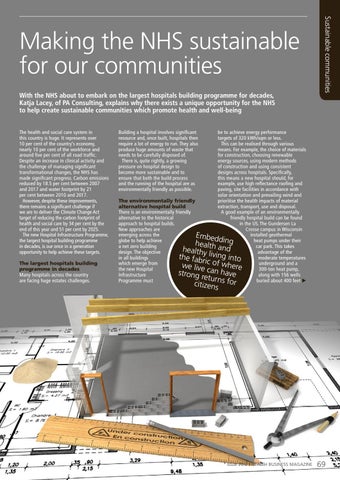With the NHS about to embark on the largest hospitals building programme for decades, Katja Lacey, of PA Consulting, explains why there exists a unique opportunity for the NHS to help create sustainable communities which promote health and well-being The health and social care system in this country is huge. It represents over 10 per cent of the country’s economy, nearly 10 per cent of the workforce and around five per cent of all road traffic. Despite an increase in clinical activity and the challenge of managing significant transformational changes, the NHS has made significant progress. Carbon emissions reduced by 18.5 per cent between 2007 and 2017 and water footprint by 21 per cent between 2010 and 2017. However, despite these improvements, there remains a significant challenge if we are to deliver the Climate Change Act target of reducing the carbon footprint of health and social care by 34 per cent by the end of this year and 51 per cent by 2025. The new Hospital Infrastructure Programme, the largest hospital building programme in decades, is our once in a generation opportunity to help achieve these targets. The largest hospitals building programme in decades Many hospitals across the country are facing huge estates challenges.
Sustainable communities
Making the NHS sustainable for our communities be to achieve energy performance targets of 320 kWh/sqm or less. This can be realised through various means. For example, the choice of materials for construction, choosing renewable energy sources, using modern methods of construction and using consistent designs across hospitals. Specifically, this means a new hospital should, for example, use high reflectance roofing and paving, site facilities in accordance with solar orientation and prevailing wind and prioritise the health impacts of material The environmentally friendly extraction, transport, use and disposal. alternative hospital build A good example of an environmentally There is an environmentally friendly friendly hospital build can be found alternative to the historical in the US. The Gundersen La approach to hospital builds. Crosse campus in Wisconsin New approaches are installed geothermal emerging across the Embed d heat pumps under their globe to help achieve i n g health car park. This takes a net zero building a n d healthy advantage of the design. The objective the fab living into moderate temperatures in all buildings ric of w underground and a which emerge from here we live 300-ton heat pump, the new Hospital c a n have strong along with 156 wells Infrastructure returns buried about 400 feet E Programme must fo Building a hospital involves significant resource and, once built, hospitals then require a lot of energy to run. They also produce huge amounts of waste that needs to be carefully disposed of. There is, quite rightly, a growing pressure on hospital design to become more sustainable and to ensure that both the build process and the running of the hospital are as environmentally friendly as possible.
citizens
r
Issue 20.2 | HEALTH BUSINESS MAGAZINE
69














